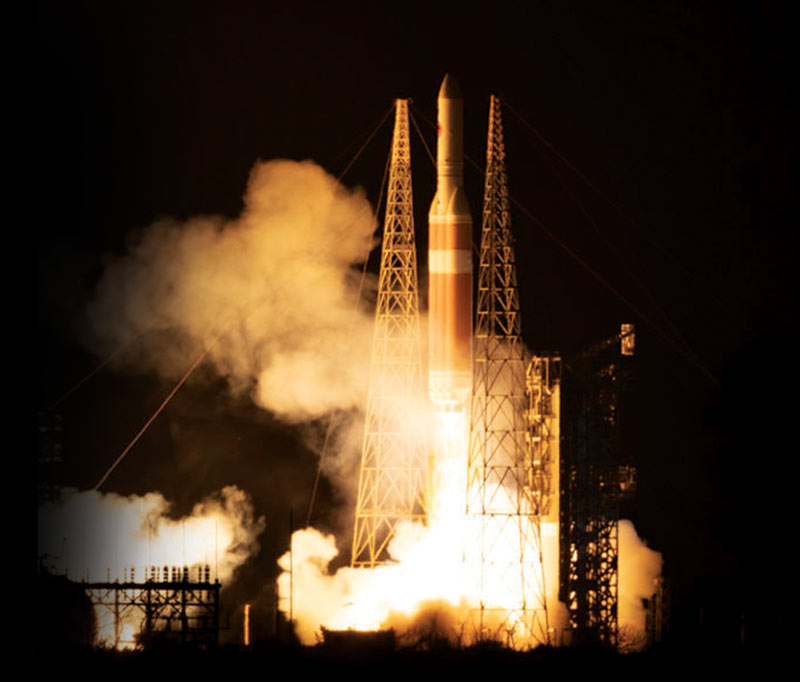Physics in the News
Fall
2018
Special Feature
Physics in the News
Rachel Kaufman, Editor
Noodling on a Spaghetti Mystery
It is practically impossible to break a dry spaghetti noodle into exactly two pieces. Try it—odds are good that you'll end up with three or even four fragments.
Even Richard Feynman spent time noodling over the conundrum. Inventor Danny Hillis wrote in a 1994 Feynman biography that he and the famed physicist spent “hours coming up with crazy theories. We ended up with broken spaghetti all over the kitchen and no real good theory about why spaghetti breaks in three.” French physicists solved the answer of why in 2005, earning themselves an Ig Nobel prize for describing the “snap-back” wave that fractures the spaghetti into multiple pieces.
But the story doesn't end there; in 2015, two MIT students wanted to see if it really was possible to break spaghetti into exactly two pieces. They eventually built a mechanical device to reliably bend and twist hundreds of spaghetti noodles.
The trick? If you twist spaghetti nearly 360 degrees, then slowly bend it, it will snap exactly in two. The work was reinforced by a mathematical model developed by another MIT student and the French scientists who developed the original spaghetti theory. The model found that as the spaghetti unwinds from the twist, it creates a twist wave that travels faster than the snap-back wave, dissipating extra energy.
“It will be interesting to see whether and how twist could similarly be used to control the fracture dynamics of two-dimensional and three-dimensional materials,” co-author Jörn Dunkel, associate professor of physical applied mathematics at MIT, said in a statement. “In any case, this has been a fun interdisciplinary project started and carried out by two brilliant and persistent students—who probably don't want to see, break, or eat spaghetti for a while.”
DOI: 10.1073/pnas.1802831115
IceCube Hits Pay Dirt
Scientists have, for the first time, traced a neutrino back to its source.
In July, physicists working with data taken at the IceCube Neutrino Observatory in Antarctica reported in Science that they had detected a single neutrino and figured out exactly where it came from: a blazar, a giant galaxy with a black hole at its core, 4 billion light-years away.
Physicists have been hoping to find the sources of neutrinos for decades, because they’re related to cosmic rays, with one key difference. Cosmic rays, being charged particles, change their trajectory as they zip through the galaxy at insanely high energies. (The highest-energy cosmic-ray particle ever recorded was two million times as energetic as the protons accelerated at the Large Hadron Collider.) Neutrinos are essentially inert, so they travel in a straight line. That means when we detect one, we can theoretically trace it back to where it came from.
That happened for the first time when a single neutrino hit IceCube in September 2017 from somewhere in the direction of Orion. Researchers trained their observatories around the constellation to find a more precise source, and the Fermi Gamma-Ray Space Telescope delivered: It detected a jump in energy coming from a blazar known as TXS 0506+056.
The discovery opens up a new branch of so-called multimessenger astronomy. Just as LIGO’s detection of gravitational waves two years ago allowed astrophysicists to begin studying the skies by looking at not just light but light and gravity, now scientists can add neutrinos—and their sources—to the list of observations we can make. //
DOI: 10.1126/science.aat2890 and 10.1126/science.aat1378
To the Sun!
feature-rocket-web.jpg

At Cape Canaveral Air Force Station’s Space Launch Complex 37, the Delta IV Heavy rocket with NASA’s Parker Solar probe, lifts off at 3:31 a.m. EDT on Sunday, Aug. 12, 2018. The spacecraft was built by the Applied Physics Laboratory of Johns Hopkins University in Laurel, Maryland. The mission will perform the closest-ever observations of a star when the probe travels through the Sun’s atmosphere, called the corona. The probe will rely on measurements and imaging to revolutionize our understanding of the corona and the Sun–Earth connection. Photo credit: NASA/Kim Shiflett
The Parker Solar Probe successfully launched August 12 on a Delta IV Heavy rocket. It will spend the next seven years gracefully pirouetting closer and closer to the Sun, until its closest approach, under 9 solar radii (about 6.2 million km) from the photosphere, the closest any human-made probe has ever been to our nearest star.
This places it solidly within the corona, or outer atmosphere, of the Sun. Scientists hope to learn more about how and why the corona is so hot (about 1 million kelvin) compared to the Sun’s surface (about 5800 K). They’re also hoping to study in depth the Sun’s magnetic field, which creates and accelerates the solar wind.
The probe is named for astrophysicist Eugene Parker, who coined the term “solar wind.” It’s also the first NASA spacecraft named after a living person.
Learn more about Parker at: https://www.nasa.gov/content/goddard/parker-solar-probe.
